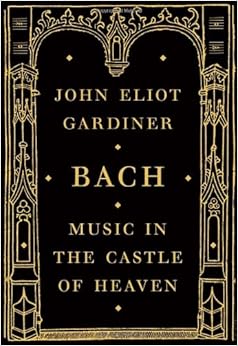John Eliot Gardiner has written a big book on J.S. Bach which focuses on the choral music, especially music Bach composed for use in Lutheran worship. I read it this past Summer and I’ve been meaning to jot down a few thoughts before dog-ears straighten themselves out and memory fades (which happens rather quickly for me these days – I blame it on the kids). It’s a delightful book. The way to read it is with the recordings at hand. I used one of those $10/month music services. I would look up a recording on my smartphone for the particular work being discussed (sometimes Gardiner’s own recording) and listen while reading Gardiner’s passionate commentary. You can also easily find translations of the texts online.
I was unfamiliar with most of this music. I know there are some great Bach enthusiasts and experts around First Lutheran Church. It’s been fun asking what people think of Gardiner. My sense is that he makes

Bach: music in the castle of heaven by John Eliot Gardiner. Knopf: 2013.
Bach’s music sound edgy. Edgy church music: is that a contradiction in terms? It seems like what many of us like about church music is that it’s so conventional. We want the reverent, spiritual sounding music that goes well with candles, or the warm gospel hymns we grew up with, or the top 40 hits from Christian radio – “religious” style music, whatever that may be for us. If the music is unconventional, strange or even disturbing, it’s probably best kept for the concert hall for people who are in to that sort of thing.
It seems like Gardiner is always saying about Bach’s music, “the congregation would have never heard anything like this.” For one thing, Bach could surprise people with the character of the music he would introduce at some event. He would compose serious, somber music for performance at the local coffeehouse, and then surprise people with more lively, secular style music in church. (pg.254) But he seems to have been especially “edgy” in making bold efforts to compose music that would fit the biblical message. So maybe say he had a prophetic edge?
Gardiner suggests that some of Bach’s most exciting innovations in music came about by way of Bach pursuing the best possible musical fit with whatever scripture passage he was working with.
I think of those Sundays when we hear scripture texts about temples crashing, the moon turned to blood and the coming of the Son of Man. What to sing? In our hymnal’s index there’s plenty of suggested hymns for themes like “grace” and “hope but, alas, no entries for “apocalyptic devastation.” The Cantata BWV 20, O Ewigkeit, du Donnerwort musically conveys the quaking of a terrified heart, the chattering of teeth and “bubbling stream .. denied to the rich man” through two voices in descending “anguished chromaticism.”(pg317) The result, says Gardiner, is music of a daring intensity that anticipates Beethoven. (pg314)
A happier text is Psalm 149-150: “Sing to the Lord a new song … let them praise his name with dances, with drums and harps let them play to him … everything that has breath praise the Lord!” A motet based on these texts – BWV225, Singet dem Herrn – is apparently what piqued Mozart’s interest in studying Bach (pg472). It’s technically demanding music for two choirs. Voices are used to convey the presence of harps and drums and even other instruments. It’s exciting to listen to: says Gardiner: “some of the most exhilarating dance-impregnated vocal music Bach ever wrote.”(pg472) Gardiner often mentions Bach’s use of dance music to convey the joy of the gospel. He thinks this may be related to Bach’s family life, where singing and drinking together would lead to dance at the end of the evening. Gardiner doubts that the Lutheran clergy of Bach’s day would have found such “bursts of festive creativity” acceptable in church. (pg475) But give us a chance – we clergy eventually come around! What is the music like that makes us want to move in our pew? Enthusiastic singing? Syncopated rhythms? Latin? Swing?
A couple more thoughts in a Lutheran vein… There’s not much in this story about the influence of what I take to be Martin Luther’s own emphasis on congregational participation in the music. Indeed, congregational participation in worship itself doesn’t seem to have been emphasized in Bach’s day. In part, church was a place you were expected to be and be seen. There’s a funny section describing how, at St. Thomas Church in Leipzig, there may have been paper airplanes thrown about and dogs running loose in the sanctuary while Bach was introducing some astonishing masterpiece.
Also, the chapter “Collusion or Collision” is about how sometimes Bach’s music went along with the biblical text, but sometimes “collided” or went against the text in interesting ways. Gardiner pauses at a couple of places in the book to reflect on how Bach wasn’t just delivering doctrine, but the more universal, transforming and truth-telling experience that music can impart. My thought is that our “chief” doctrine – God’s grace in Christ – bridges the divide, a doctrine that’s like music in our ears. I think of the sing-song voice of some preachers in the African American tradition. When we’ve really heard the about God’s grace in its doctrinal truth, the Holy Spirit fills our hearts with love and makes us want to sing and dance. More about that another time ….

